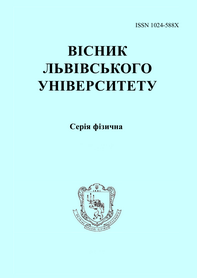DOI: https://doi.org/10.30970/vph.60.2023.26
Quantum-Chemical Simulation of the Activation and Conversion of EAC of Niobie- and Tantalum-Containing Molts on the Surface of the Carbon Electrode
L. O. Solianyk

| Visnyk of the Lviv University. Series Physics
60 (2023) ñ. 26-35
DOI: https://doi.org/10.30970/vph.60.2023.26 Quantum-Chemical Simulation of the Activation and Conversion of EAC of Niobie- and Tantalum-Containing Molts on the Surface of the Carbon ElectrodeL. O. Solianyk |  |
(íå ìåíøå 1800 çíàê³â) The work is devoted to quantum-chemical modeling of the influence of the adsorption properties of the glassy carbon electrode surface on the formation mechanism of electrochemically active niobium- and tantalum-containing complexes in dilute melts. The parameters that determine their stability and reactivity in electroreduction processes were calculated for the studied objects - the energy of the cation-anion bond, the value of the energy gap \DeltaE, which was estimated as the difference between the energies of the upper filled and lower vacant molecular orbitals, and the activation energy and adsorption of electrochemically active complexes on the electrode surface. It was found that in the bulk phase of niobium- and tantalum-containing melts, stable electrochemically active complexes are formed, in the outer shell of which are coordinated cations 3Li\textsuperscript{+}, 2Ca\textsuperscript{2+}, 2Mg\textsuperscript{2+}, which participate in electroreduction processes and are adsorbed on the electrode surface. It was established that cationic impurities significantly lower the energies of the upper filled and lower vacant molecular orbitals for Nb(Ta)F\textsubscript{7}\textsuperscript{2-}, indicating the significant role of the cationic environment in increasing the electroreducing ability of electrochemically active complexes. Electron-accepting properties of niobium and tantalum in electroreduction reactions were revealed. By means of electrochemical measurements, a change in the charge transfer rate constants with a change in the acidity of the melt was determined. The work focuses on determining the dependence of the adsorption energy of niobium and tantalum on the type of electrochemically active niobium- and tantalum-containing complexes. It was found that the adsorption energy for niobium is slightly higher than for tantalum, and the distance to the electrode surface is shorter. It is suggested that the ability to control the interaction between electrochemically active complexes and the surface is regulated by the cationic composition of the melt contacting the electrode surface.